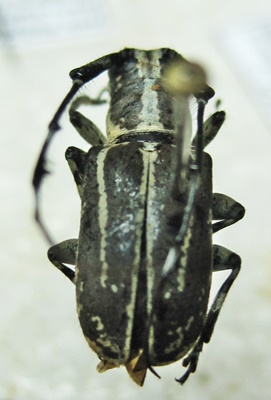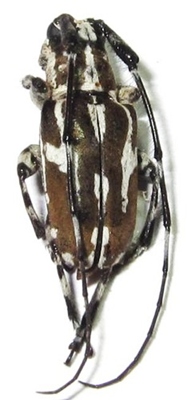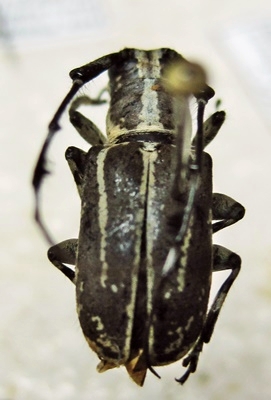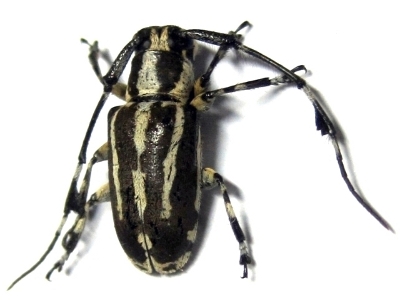| Author |
 Topic Topic  |
|
|
BillTyson
Member Rosenbergia
   
USA
1200 Posts |
 Posted - 09/10/2015 : 02:08:56 Posted - 09/10/2015 : 02:08:56



|

39.99 KB
Luzon, June, 12 mm.
another Cacia sp. |
Edited by - BillTyson on 10/10/2015 00:05:04 |
|
|
Xavier
Scientific Collaborator
    
France
12338 Posts |
 Posted - 09/10/2015 : 08:22:11 Posted - 09/10/2015 : 08:22:11



|
| A Cacia sp. |
 |
|
|
dryobius
Member Rosenbergia
   
USA
1889 Posts |
 Posted - 09/10/2015 : 13:40:12 Posted - 09/10/2015 : 13:40:12



|
| Bill, this genus is in sore need of a revision. As with many Philippine genera (Glenea, Cereopsius, Sybra..), you have numerous species on many, many islands. Undoubtedly, the populations get separated, then probably re-unite, over and over. I have Cacia identified by Hudepohl and Yamasako ... with different names. What I'm saying is that some species have different vatiations to the patterns on the elytra. A good collection of Philippine Cerambycidae is going to have many specimens that can only be identified to genus. Yamasako is currently the best expert on Oriental Mesosini, however, I think he is not interested in Cacia at the moment. But, I would suggest that you correspond with him anyway, because he has been very helpful to me. |
 |
|
|
BillTyson
Member Rosenbergia
   
USA
1200 Posts |
 Posted - 09/10/2015 : 15:59:45 Posted - 09/10/2015 : 15:59:45



|
| Does he have an email address? |
 |
|
|
dryobius
Member Rosenbergia
   
USA
1889 Posts |
 Posted - 09/10/2015 : 20:21:11 Posted - 09/10/2015 : 20:21:11



|
this is the name and address as given on one of recent publications:
JUNSUKE YAMASAKO
JSPS Research Fellow, Department of General Systems Studies, Graduate School of Arts and Sciences, The University of Tokyo, Komaba 3-8-1, Meguro, Tokyo 153-8902, Japan. E-mail: mesoxxmesosa@hotmail.com |
 |
|
|
Francesco
Forum Admin
    
Luxembourg
9511 Posts |
 Posted - 09/10/2015 : 22:30:23 Posted - 09/10/2015 : 22:30:23




|
However, this one seems to be Cacia (Coreothrophora) interruptovittata Heller, 1923, endemic from Luzon.
Another picture here. |
 |
|
|
BillTyson
Member Rosenbergia
   
USA
1200 Posts |
 Posted - 10/10/2015 : 00:05:04 Posted - 10/10/2015 : 00:05:04



|

37.9 KB
Here is what I, and some others have been calling interruptovittata.
Is the species that variable or is this another one? |
 |
|
|
dryobius
Member Rosenbergia
   
USA
1889 Posts |
 Posted - 10/10/2015 : 03:35:22 Posted - 10/10/2015 : 03:35:22



|
I agree with Francesco, your first specimen is C. interruptovittata.
Heller provides a drawing in his original description which is an excellent comparison.
The second specimen in your post is a different species in my opinion.
Besides the pattern of the elytra, your two specimens do not have the same dark color on the elytra... one is more brownish. |
 |
|
|
BillTyson
Member Rosenbergia
   
USA
1200 Posts |
 Posted - 10/10/2015 : 07:46:26 Posted - 10/10/2015 : 07:46:26



|
Well, at least I know the name of one of them.
Many thanks, guys. |
 |
|
|
Francesco
Forum Admin
    
Luxembourg
9511 Posts |
 Posted - 10/10/2015 : 11:14:06 Posted - 10/10/2015 : 11:14:06




|
Dear Billy, you should not have modified the first part of the topic adding a new picture, since the sense of the replies has been modified.
Consequently, I have stopped the Forum and moved your modification as a new reply.
Coming back to your topic...
  
Are these three forms from Luzon (female, female, male) really different species? |
 |
|
| |
 Topic Topic  |
|


